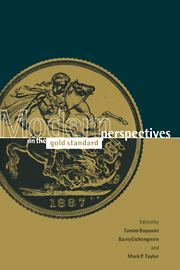Book contents
- Frontmatter
- Contents
- List of figures
- List of tables
- Notes on the contributors
- I Introduction
- II Operation of the gold standard
- III Adjustment mechanisms
- IV Monetary issues
- 9 Money demand and supply under the gold standard: the United Kingdom, 1870–1914
- 10 Stability and forward-looking behavior: the demand for broad money in the United Kingdom, 1871–1913
- V Exchange rate behavior
- VI Conclusions
- Index
10 - Stability and forward-looking behavior: the demand for broad money in the United Kingdom, 1871–1913
Published online by Cambridge University Press: 05 November 2011
- Frontmatter
- Contents
- List of figures
- List of tables
- Notes on the contributors
- I Introduction
- II Operation of the gold standard
- III Adjustment mechanisms
- IV Monetary issues
- 9 Money demand and supply under the gold standard: the United Kingdom, 1870–1914
- 10 Stability and forward-looking behavior: the demand for broad money in the United Kingdom, 1871–1913
- V Exchange rate behavior
- VI Conclusions
- Index
Summary
Introduction
The demand for money in the United Kingdom during the heyday of the international gold standard, 1870–1913, has been studied quite intensively. Some studies (notably Friedman and Schwartz, 1982; Bordo and Jonung, 1987; Hendry and Ericsson, 1991) have examined a whole century of data from 1870, while others (Mills and Wood, 1978; Capie and Rodrik-Bali, 1985), have concentrated on the gold standard years. In this chapter we follow the latter group of authors; for, despite extensive study, there remain important unresolved questions about money demand in this period. In particular, although there is broad similarity among long-run estimates, estimated short-run demand functions appear to differ significantly. One of the aims of this chapter is to estimate more precisely than before the shortrun function by applying recent econometric techniques to the best currently available data. We also test a forward-looking model of money demand on this data, which goes some way towards explaining the form of the short-run dynamics.
We address these issues by application of a number of recently developed econometric techniques. In particular, we apply the Johansen (1988) method of estimating cointegrating vectors (Engle and Granger, 1987) to estimate the parameters of a long-run UK money demand function for the gold standard period, and to test economic hypotheses such as long-run price and income homogeneity in money demand.
- Type
- Chapter
- Information
- Modern Perspectives on the Gold Standard , pp. 284 - 306Publisher: Cambridge University PressPrint publication year: 1997



